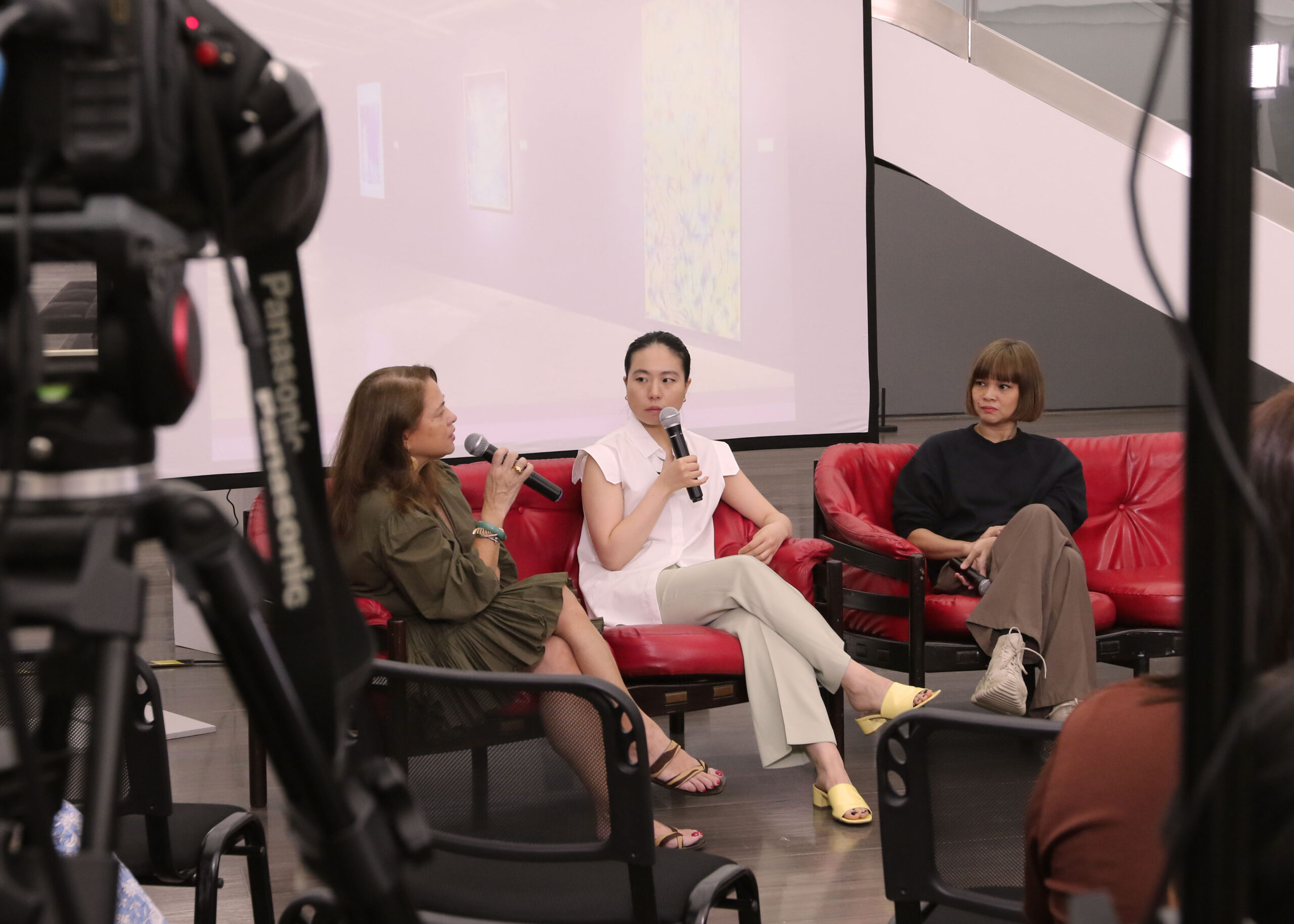From imbalances in art history to the state of institutions today, the roundtable discussion at The Metropolitan Museum of Manila takes a deeper dive into “Wild”
For its latest edition of M Conversations, the institution led a curatorial walkthrough and discussion that navigated the nuances of art and in particular, the relation of abstraction and nature in their latest exhibition, “Wild: Women Abstractionists on Nature” at the Metropolitan Museum of Manila.
“In abstract art, there’s like a little bit of suspicion around it sometimes. Figurative art is quite easy to understand, right? It’s representational and all that. But in abstract art, you still get people who make comments like, ‘Oh, I can do that, you know, anyone can do that’… But there are many layers.”
This is just one example of the mix of incisive insights and pertinent issues that Bambina Olivares of the Metropolitan Museum of Manila raised during a roundtable discussion on Mar. 27.
READ MORE: The M’s Bambina Olivares shows us what goes into curation—in art and life
The talk was moderated by Olivares, the museum’s special exhibitions and projects consultant, who sat down with “Wild” curator Kathy Huang and artist Corinne de San Jose.
Visiting from New York and working with businessman and collector Tim Tan, the independent curator was commissioned for experience as a managing director for art advisory and special projects at both the New York and LA-based spaces of gallery Jeffrey Deitch. It was here where she curated the figuration-centered show, “Wonder Women” featuring 40 Asian diasporic women and nonbinary artists. She also organized exhibitions such as “Judy Chicago” in Los Angeles and Dominique Fung’s “It’s Not Polite To Stare.”
Meanwhile, de San Jose is an artist known to many in Manila. An award-winning sound designer and multidisciplinary artist, she creates self-reflective and reflexive work, often with a performative aspect. Her visual aesthetic is informed by sound, in particular the silence in a deafening world. Olivares describes how de San Jose documents, “varieties of alterations through her recurring subjects, such as the female body whilst analyzing how it changes them.”
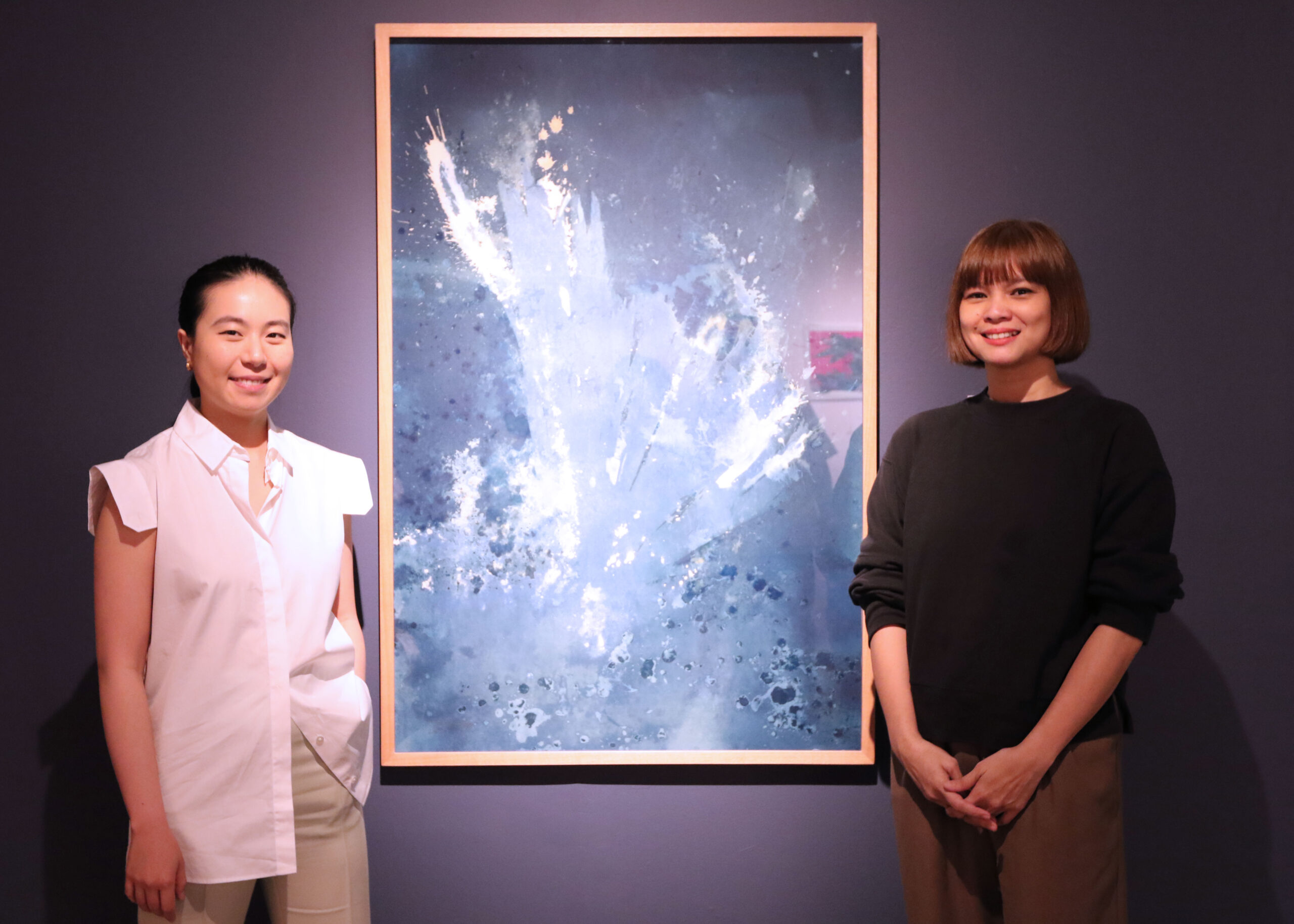
READ MORE: Metropolitan Museum of Manila launches ‘Wild: Women Abstractionists on Nature’
Taking a deeper dive into the wild, the roundtable explored the works of globally acclaimed female abstract artists, including those from the Philippines and the broader diasporic community.
The exhibited work features contemporary women abstractionists in younger generations while also spanning multiple generations, as they delve into the interconnectedness between art and nature.
Huang’s curation and the universal language of abstraction transcend borders. However, to the surprise of the audience, many of the international works came from private collections in Manila, showing how Filipinos are active patrons of local and international art.
In celebration of this all-women programming, the roundtable was also recorded live, reaching a wider audience exposure.
Both the roundtable and exhibition signified new dialogues between international and Filipino voices, as this latest edition of M Conversations spans the imbalance of women in art history and revisionist efforts. They dove into art institutions such as the differences between men- and women-owned galleries and then narrowed down to the all-women programming of ‘Wild’ at the Metropolitan Museum of Manila.
On imbalances in art history
Bambina Olivares (BO): Abstraction is obviously a 20th-century invention. When we were discussing this exhibition, we were talking about correcting some imbalances in art history. That’s why it was really important to do an all-women’s show—not only because it’s Women’s Month but also because of how women have been marginalized in the world of abstraction throughout art history. Tell us about that marginalization, and how this exhibition is a step towards correcting that.
Kathy Huang (KH): When I think about the beginnings of abstract expressionism, which really came about in the ’40s, and Æ50s after World War II, what I find really interesting is that it’s not like ‘abstract expressionism without women’—it was just that the history was displaced by men. These women were always working within this movement. But I think at the time, some of them were seen as secondary to their husbands—so, Lee Krasner (and Jackson Pollock), and Elaine de Kooning (and Willem de Kooning).
In recent years, we’ve seen the correction of highlighting the women who are working at this moment. Recently, there was a show at the Pompidou, of women in abstraction, and also a show at the Denver Art Museum of the women of abstract expressionism.
I think there’s this revisionist correcting happening. With this show, what I wanted to highlight were the contemporary artists working. My generation but also, multiple generations. There are artists as young as in their 20s, which is crazy to me. A lot of the artists are drawing on influences from abstract expressionism. There’s a lot we still have to do to highlight these women. But something I said during the opening was that I think that a lot of the most interesting and ambitious abstract work today is being made by women. And I think that the difference between eight decades ago and now is that there are fewer social and institutional barriers to enter the art world.
“That’s why it was really important to do an all-women’s show—not only because it’s Women’s Month but also because of how women have been marginalized in the world of abstraction throughout art history.” – Bambina Olivares
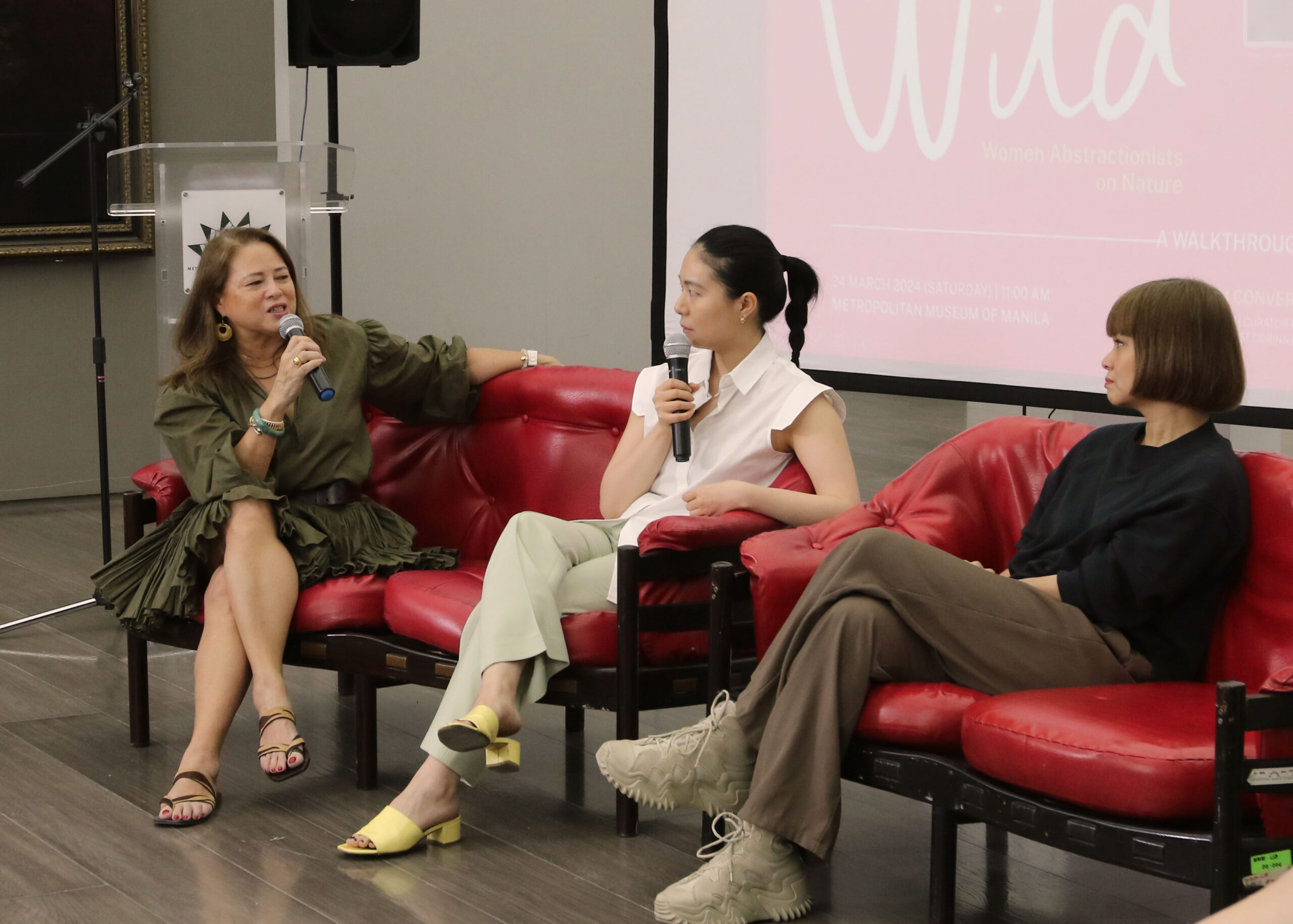
BO: When we talk about changes today in society, in representation and the way women, minorities, or people of color are being represented in the arts and various other cultural platforms, we talk a lot about gatekeeping, and how traditionally, men were the gatekeepers. This also led to barriers being created for women and people of color to enter. We do have a lot of galleries run by women [in the Philippines]. Corinne, especially as a woman working here, have you encountered that kind of gatekeeping? Tell us a little bit about your journey as an artist.
Corinne de San Jose (CSJ): I think I was lucky. I started making art late. Photography was my base, but I really started embracing the art world late in life. My first show was in my early 30s. I started with Silverlens and these are women, strong women. I was lucky in that sense. I had the privilege to have always been surrounded by women in the art world.
But when you talk about gatekeeping, it’s still there. If one were a young student from nowhere, with no contacts, there are a lot of intricacies you still have to navigate. A lot of galleries, for instance, or established male artists, are dictating aesthetics.
“I was lucky in that sense. I had the privilege to have always been surrounded by women in the art world. But when you talk about gatekeeping, it’s still there.” – Corrine de San Jose
READ MORE: ‘The personal is global,’ says Nicole Coson in latest New York exhibit
BO: [Kathy], you worked for a gallery headed by men, but you spearheaded several exhibitions that really centered women and empowered women as artists. How has that been for you?
KH: The gallery that I work for is founded by a man but he was always very supportive of my vision. I started working at the gallery as an assistant seven years ago, and to be able to shape the program now the way that I want is very special. It’s not common at such an established gallery, to be able to do that.
I came in with this vision because I’d studied contemporary Asian art in grad school. I always wanted to highlight Asian American and diasporic artists because it was something that I didn’t see in the art world. I was in the New York art world and before that, I went to grad school in London. So I think my goal was to lower the gate for Asian artists, particularly in the West.
Linking back to the Metropolitan Museum of Manila’s “Wild” and its women artists
BO: One of your revelations in this exhibition is a Filipino-Canadian artist called Sarah Jimenez. Some of us follow the art world and we’re still quite unfamiliar with her, so it’s nice to discover her work. The way you placed it in the exhibition with all these large-scale paintings, and then suddenly these three small pieces by Sarah Jimenez was very impactful, actually. How did you find her?
KH: The great thing about the New York art world is that I’m surrounded by all these amazing artists, and they also are friends with other artists and always make recommendations. And I think that’s one of the wonderful things… that so many of them want their friends to succeed. She was good friends with another Filipino artist living in New York and already sort of had that connection. They spearhead this community initiative called Asian-ish, and it’s all of the Asian diasporic creatives who live in New York.
She makes these abstracted landscapes but there’s so much history embedded into it that’s so specific to the Philippines.
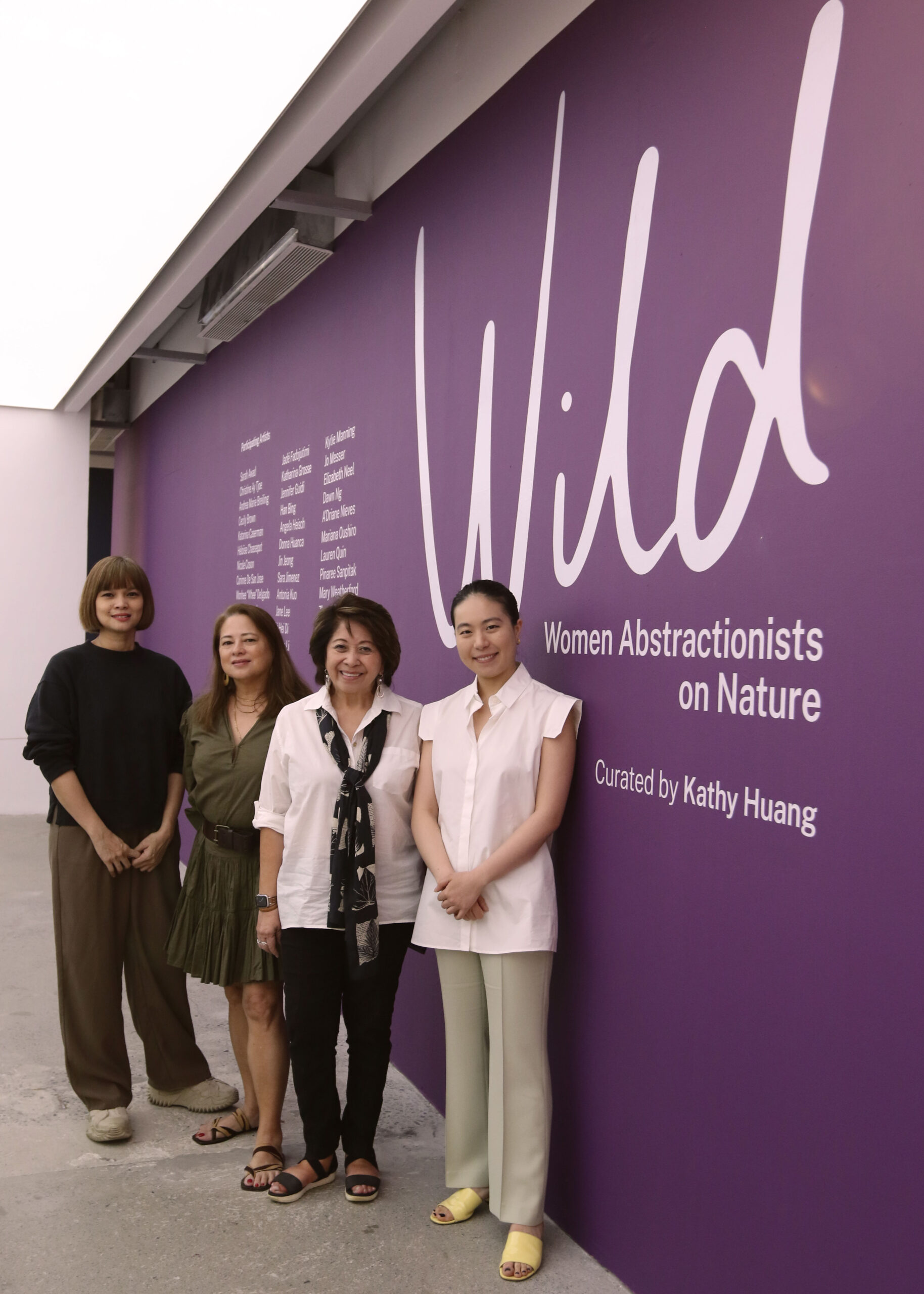
BO: When we were drawing up the wish list for the show, Corinne was there. It was very important for us to have Filipino artists as well working in the language of abstraction. You were saying earlier Corinne that you really are drawn to abstraction. You’re also a sound artist and there’s a certain abstraction with sound performance, right? There are lots of layers. Can you just take us through that process of interpreting all these layers in your work?
“It was very important for us to have Filipino artists as well working in the language of abstraction.” – Bambina Olivares
CSJ: So much of my process is really thinking—a set of different thoughts and how to put them together. I had to work my way through this hubris—it’s the word I would use—to just decide that this is art, or the work now.
Somebody was asking how long an exposure is. It’s about 10 to 15 minutes. I mean, for some people, it takes years to make paintings. But we’re also just conduits of something. And I’m also embracing that. That’s part of my process now, just piecing these ingredients or these elements. And I would say 75 percent of my process is really thinking and writing.
One of the things I love about the cyanotype process is that it’s one of the earliest photographic processes. You just have chemicals that react to UV light. What I love about this process is it was started by a woman, Anna Atkins. The way she used it was to document plants and botanicals. They’re blueprints, actually.
What I’ve always loved about photography is that there will be a moment when it’s unpredictable. Especially because I was old enough to start with analog and film. So cyanotype became this more predictable but also at the same time, very forgiving medium. Because my work also involves time and documentation of time, it’s very important to have that mastery of how long an exposure is. The elements are all part of making the artwork and it’s also my environment, it’s the time where I’m at, the place where I’m in. That’s why I love that process.
On the curation of “Wild” at the Metropolitan Museum of Manila
BO: In terms of curation, I wanted to ask also how you laid out the exhibition. You gave it a free-flowing movement throughout the exhibition. You see a lot of exhibitions where they have a wall text to separate sections to give the audience a better understanding of the themes in a particular section.
You use colors somehow to designate areas. Can you tell us a little bit about those distinctions and what themes they established?
KH: I’d say that there were four overarching themes. It’s organized in these quadrants and when you walk in, I want to show works that draw on different themes.
So in the first room you see that Jadé Fadojutimi painting, which is a giant emotional landscape. But there’s also the essence of flora. Then there’s a Cecily Brown, which is reminiscent of a carcass. I wanted to show there are themes of this literal interpretation of nature but also comments on the body and flora and fauna.
Then when you move to the right, you’re confronted by this bright yellow wall. That section to me is really about the cosmos and the sun. So another artist, Camilla Engström, has made this work that’s very clearly a sun, but then you’re seeing it through this, like an abstract portal. And, she was saying that looking at the sun and thinking and meditating on the sun is like reaching your deeper self, which is also connecting back to this idea of self-discovery through nature.
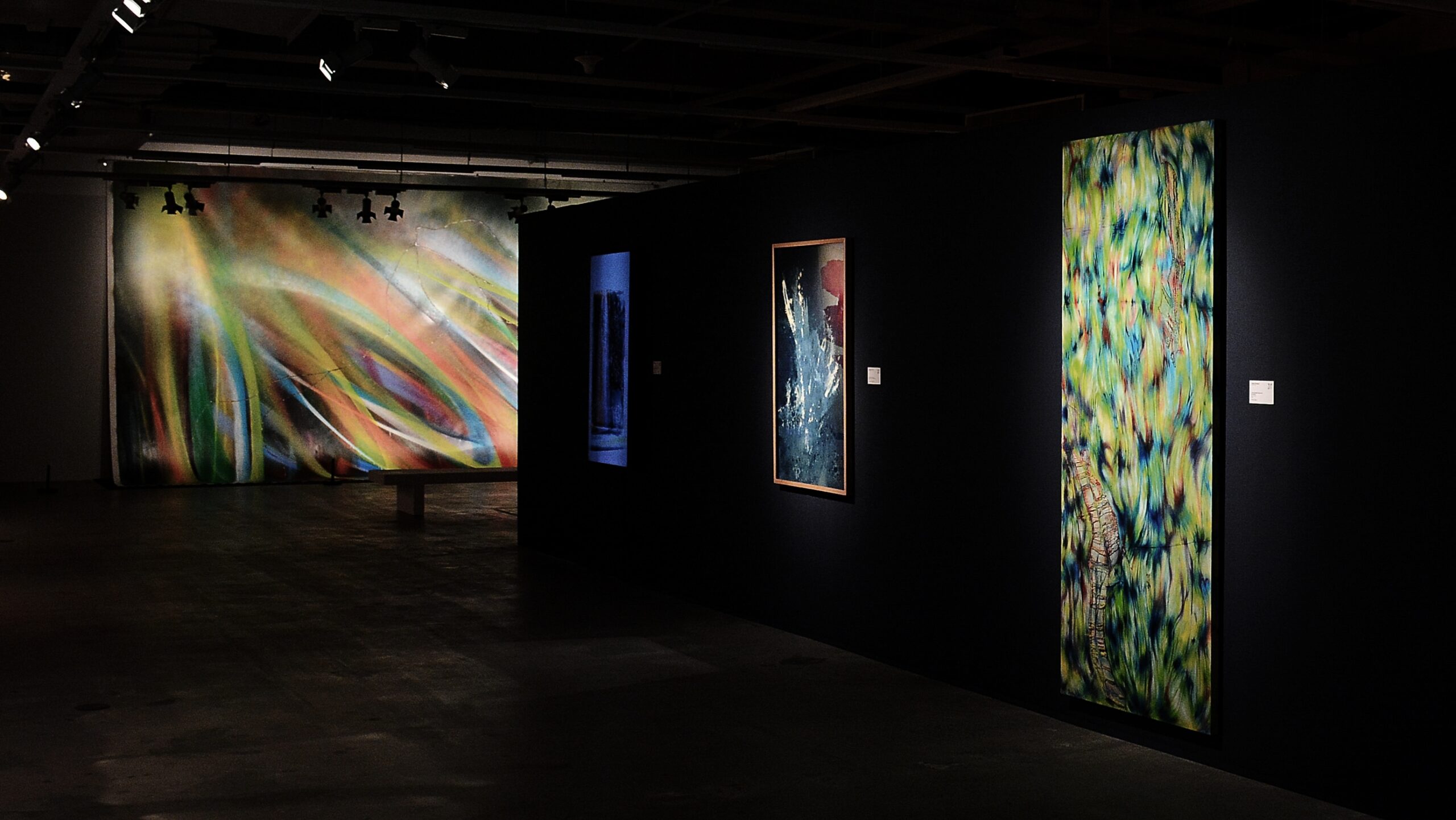
Moving past that, you come to the section where Corinne’s work is, and quite a few works that draw on water very specifically. Corinne’s work is a really good example of that—work made when you’re at a residency and have access to the beach, sand, and pebbles. Also, Donna Huanca who physically uses water and ice as a medium and then videos the process of this melting pigment.
Moving towards the end of the exhibition, I wanted to bring it full circle— back to the body, which is where we see Sarah Awad’s landscapes that also incorporate figures. Also Zhang Zipiao where the work is called ‘Peony.’ I also think of it as corporeal and bodily, bringing it full circle back to having your own body, your own self, reconnecting with nature.
I wanted there to be this flow starting with paintings that draw on all of these different topics from the sun to landscapes to water—and then back to the body.
That was the idea for the show.
“I’d say that there were four overarching themes. It’s organized in these quadrants and when you walk in, I want to show works that draw on different themes… I wanted there to be this flow starting with paintings that draw on all of these different topics from the sun to landscapes to water—and then back to the body.” – Kathy Huang
READ MORE: Hats Off to Bambina Olivares
BO:: Each piece is amazing in this exhibition. But Katharina Grosse, the big one, is a showstopper. Mostly because of the sheer size of it alone demands your attention. Tell us a little bit about the logistics of it, and why it was important to include it in the show, and the going beyond borders and boundaries.
KH: I’d say that was one of the more challenging ones to figure out. You might have seen that there are borders, and you’re not really supposed to see those borders. But we had to work with the physical limitations of the space. That’s something that the artist does as well. She likes to work beyond physical limitations. She spray paints on buildings, and then goes past the buildings onto the ground. So I actually think it works really well with this space in the sense that it goes beyond just the wall. That’s very much what the work is about—almost inserting yourself into a space that you don’t think can fit, will fit, or should fit.
I think also that’s how she inserts herself into the art world as well as a woman. You don’t think you should fit or can fit or will fit, but like, it’s going to fit.
“Wild: Exploring Nature Through Contemporary Abstract Art” is on public exhibition from Mar. 21 to June 22, 2024, at the Metropolitan Museum of Manila.

